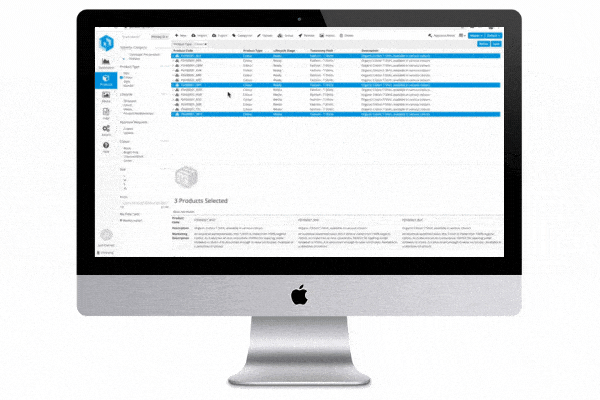Remember PIM? It’s time to reveal the many ways a PIM platform can help you improve your eCommerce SEO.
Modern PIM Software as a Service (SaaS) enables you to measure, monitor, and implement your eCommerce SEO strategy. When it comes to your product information and digital assets, apply SEO best practice into your eCommerce strategy using PIM software to appear higher in SERPs.
Pimberly – an intelligent and intuitive PIM platform, provides exceptional PIM for eCommerce SEO. With infinite power, Pimberly can store, optimize and enrich all your product data. And as a centralized hub with full visibility across every search engine, it drives the productivity of your SEO teams, helping them work smarter and faster.
Let’s look at the specific ways Pimberly will help you achieve super SEO so your eCommerce business can benefit from:
- A competitive advantage
- Increased product discovery
- More organic visitors to your site
- Increased demand
- A boost in sales and customer loyalty
We’ll cover the following:
- Keywords
- Product descriptions
- Digital assets
- Google snippets
- Mobile optimization
- Site structure
- Reviews and UGC
- Penalty reduction
- Collaboration
Keywords
Your keywords are the backbone of your eCommerce SEO strategy. Pimberly keeps your keywords organized and relevant for each product, driving optimization for increased visibility.
For instance, you can easily populate keywords at category, product, or SKU level – this can be done manually, via upload such as CSV, or link via API to your keyword generators such as Ahref. Your keywords stay fresh and relevant with minimal effort from you.
Plus, you can create unlimited numbers of keyword fields against any and all of your products with Pimberly. Then the platform can instantly inform whether your keywords are included in the required product descriptions (these might differ by channel, campaign, or time of year). If keywords are missing, you can create automated workflows to alert the appropriate team members inside or outside of your organization, saving you time and ensuring optimization.
You and your SEO team won’t be able to imagine life without Pimberly when you’ve experienced these capabilities!
Product descriptions
Pimberly can seamlessly integrate with your various sales and marketing channels, from your website to Amazon, Tik Tok, and Pinterest. This means you can easily optimize your product headings and descriptions (no matter how many) for each channel, accommodating the unique SEO algorithms of each channel.
This also applies to product and heading descriptions for different languages, locations, and campaigns. And you can also capture the required SEO characteristics for each variant, such as the length of description or keyword(s) inclusion. Pimberly will send you an alert if action is needed to improve keyword optimization for individual channels.
And let’s not forget that reader-friendly copy is one of the most important SEO ranking factors: it keeps users on the page which sends all the right signals to search engines. Pimberly can send a copy of your product description to an external engine such as Grammarly to determine its “readability”, signaling for improvements when you’ve set up relevant workflows. Same goes for plagiarism engines to help you ensure your copy is unique (which boosts SEO).
Digital assets
Ensure search engines like Google can find and prioritize your images and videos (for YouTube). For instance, make the most of product comparisons, use case stories and ‘How to’ guides. Pimberly helps boost your images’ and videos’ SEO by generating alt-tags from auto-associated assets, even if those assets have nondescript file names (such as a SKU ID)
Plus, Pimberly enables you to ensure all the images related to your product – including care instructions and regulatory certifications – are optimized for SEO and stored against the right product. This is a continuous, automatic process – Pimberly will constantly refresh your alt tags so they’re always up to date, helping you stay on top of trends.
With Pimberly, you can also store transcripts against your videos. To add to that, you can send your video transcripts from Pimberly to a translation capture engine. The right workflow setup will tell you whether the video has been translated – if it hasn’t, the platform will automatically send the video to the translation engine.
When it comes to product image and video optimization for different platforms (like mobile or social), Pimberly will automatically resize and rename images to ensure they meet the requirements of the different sales channels. This improves the UX and your site speed, which is a positive SEO signal for search engines.
Google Snippets
When your page is featured as a Google Snippet, it’s a bit like winning the SEO lottery: a Featured Snippet gets approximately 8% of all clicks.14
Snippets appear on the first page of Google as a box of text that might include definitions, tables, steps or lists. Their purpose is to quickly answer a searcher’s query. It appears at the top of Google’s first results page, which is why they generate so many clicks.
How to increase your page’s chances of being a Featured Snippet? SEO tools like SEMrush and Ahrefs can help you identify keywords used in a Featured Snippet for a particular search term. This gives you an idea of what keywords to use.
You can also enter your search term in Google to see if the search engine has already given it a Featured Snippet. That’s a good signal to optimize your content for its Snippet potential. Note the format of the current snippet. For example, if it’s a definition, you’ll want a 40-60 word explanation for your search term. Having “What is X” directly above your definition will also help Google identify it.
Pimberly can increase your chances of being a Featured Snippet on Google. It helps you store multiple lists, words, images, and videos against your products in a snippet-friendly format.
And it can remind you of optimization opportunities with alerts from life cycle stages and workflows that you can determine. Essentially, this ensures your team is always on top of SEO.
Voice search
When optimizing your site for voice search, use longtail keywords that are conversational. Find out what language people use when speaking about your products. What questions do they ask?
Mobile optimization
Given that 54.8% of all website traffic is generated from mobile phones,15 having a mobile-friendly site is essential in today’s climate. If you’re not optimized for mobile, you’ll lose leads to competitors who are.
A mobile-friendly site needs written content and images that are adjusted for mobile. Pimberly automatically optimizes your assets for mobile so they’ll always be displayed in the best possible light. It also keeps your SEO team organized with the ability to store your digital assets as variants against your product records.
Site structure
With Pimberly, you have the ability to rapidly react to the latest trends – the platform helps you alter your web pages for new searches, such as:
- Changing product descriptions
- Adding new product attributions
- Changing the name of your product
- Altering your pages’ colors
All of which can be completed in bulk regardless of how many SKUs you’re managing. The beauty of PIM is being able to easily surface all your product information to gain full visibility. This means making big and/or small changes to attributes or product categories is a total breeze, and you’ll save heaps of time. You’ll be able to seamlessly stay on top of trends and react quickly to any changes in consumer behavior, which means you’ll never miss any opportunities to boost your online sales.
PIM also enables you to create structured data and multiple product categories for better site navigation, improving the customer experience and your position in SERPs.
Reviews & UGC
Thanks to Pimberly’s huge storage capabilities, you can store all product reviews and user-generated content in one place, helping your content teams work more efficiently.
This also makes it easy to publish reviews and UGC on your product pages, encouraging you to harness their power. Posts with reviews appear in over 57% of global searches.16 That’s because search engines like Google recognize their value in improving the customer experience. They prioritize product pages with diverse, high-quality reviews.
Pimberly’s reliable review, storage, and publishing capabilities ensure you don’t miss the opportunity to attract organic traffic, boost engagement, and drive sales.
Penalty reduction
Inefficient PIM will result in:
- Image mislabelling
- Duplicated content
- Unoriginal copy and images
- Keyword stuffing
All of which will negatively impact your rank in search results. For example, Google explicitly details how duplicated content is bad for SEO: “the ranking of the site may suffer, or the site might be removed entirely from the Google index, in which case it will no longer appear in search results.”17
Pimberly helps you avoid penalties by centralizing all your data. With a clear view of all your product information, issues like image mislabelling and duplicated content are easier to spot and address.
Also, minimize keyword stuffing with Pimberly. The platform can send you an alert when a keyword has been used too many times in a product description (plus, it can inform you of poor readability scores which impacts SEO).
Pimberly can also assist with duplication checks for specific fields. So, if you’re selling a product on two different sites, you can use Pimberly’s scoping feature to diversify your content depending on which channel it’s being published to. In other words, you can avoid SEO penalties from duplicate product content being published.
Collaboration
How your SEO, content, and marketing teams work together directly impacts the success of your SEO strategy (and your business’ bottom line!).
Misalignment makes teams underperform. You need shared access to your product information to help squads work smarter and faster. Pimberly gives you this and more.
Set up Pimberly by department where you can assign each team unique workflows, alerts, gate and access control.
Plus, with shared access and visibility, individuals can version control content and explain what changes they’ve made using an attached note. So everyone, no matter what team they’re in, can see the progression and why a particular approach was adopted or dropped.
Say goodbye to unnecessary emails, misunderstandings, and wasted resources. No matter where your various teams are in the product lifecycle, Pimberly enables seamless collaboration to drive the success of your SEO strategy.
To recap …
… when it comes to effective PIM for eCommerce SEO, Pimberly wins because it helps you:
- Organize and optimize your keywords
- Drive the quality of your product descriptions
- Organize and optimize your digital assets
- Boost your chances of being a Featured Snippet
- Optimize your site for mobile
- Create a user-friendly site structure
- Store and improve your reviews and UGC
- Reduce the risk of indexing penalties
- Enable seamless collaboration between teams
In short, Pimberly covers all the key characteristics of a great SEO product strategy. This means you’re more likely to experience:
- Better product discovery
- Increased click-throughs
- Lower bounce rates
- Great customer experiences
- A boost in new and repeat sales
That’s the power of advanced PIM for eCommerce SEO. Are you ready to wield it? Then it’s time for the next step.











